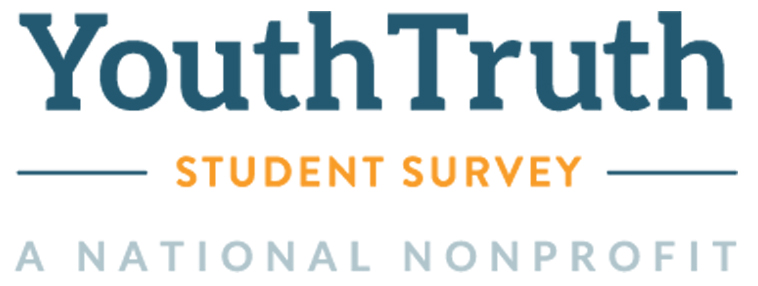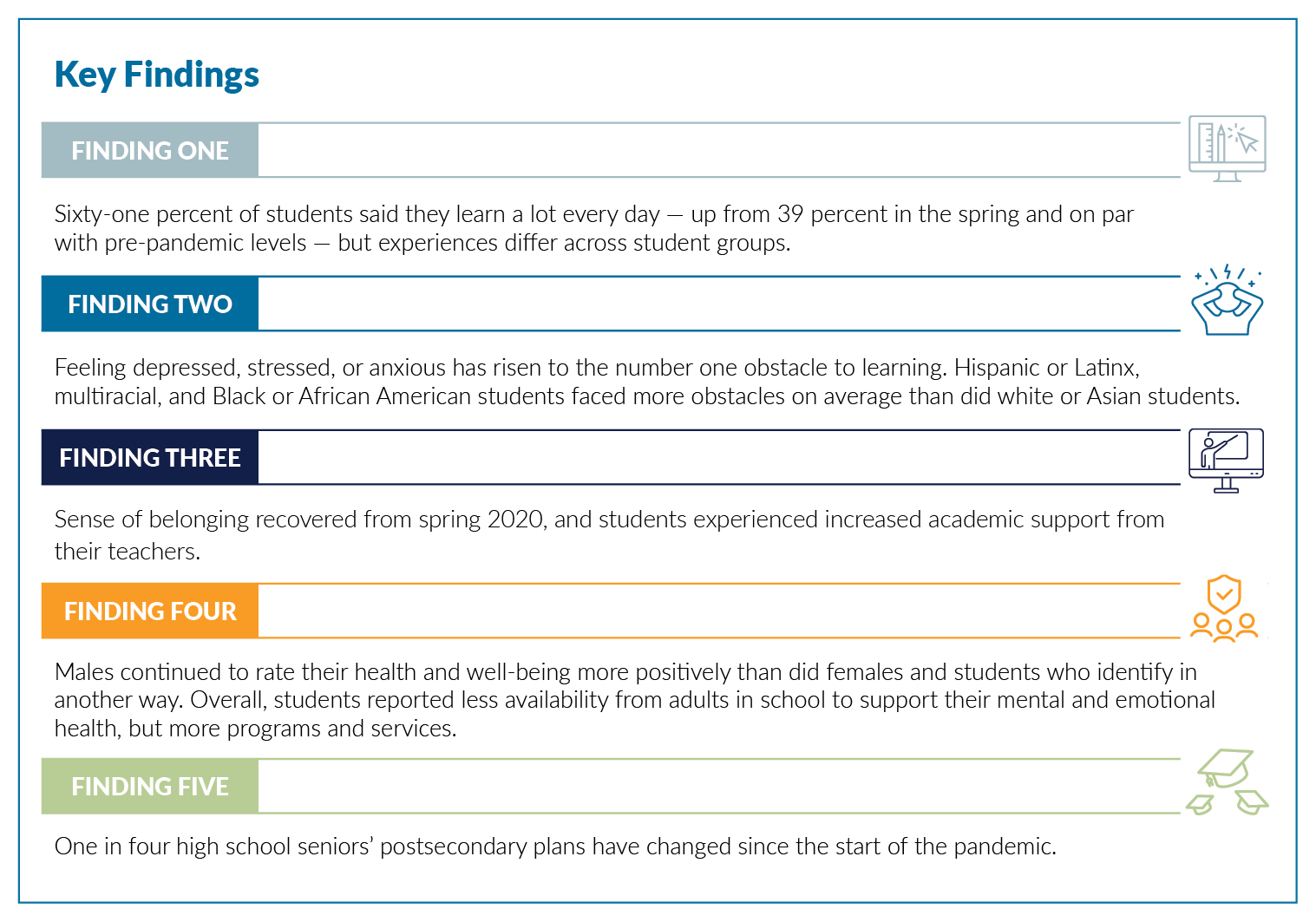In the spring of 2020, the COVID-19 pandemic required nearly all of the more than 55 million K-12 students in the U.S. to stop doing school in the way they had been taught, and engage in learning remotely instead. In response to a stark lack of firsthand data about how the pandemic and school closures were affecting students’ lived experiences this report — the second in a three-part series — explores what students have to say about learning and well-being during COVID-19.
In July 2020 YouthTruth released Students Weigh In: Learning & Well-Being During COVID-19, a national report that shared insights from more than 20,000 students about their learning and well-being during that first wave of school closures. This initial report was intended to be a one-time, standalone effort.
Yet, students continue to experience a historic period of learning during the 2020-21 school year as the pandemic evolves and they navigate ever-changing conditions in their communities. As a national nonprofit that elevates student voices on critical issues in education, YouthTruth has long asked students about their learning experiences, social-emotional development, and well-being.
To address the need for adults to hear directly from students about how the pandemic is affecting students’ experiences, this second report in the Students Weigh In series explores survey findings from more than half a million secondary students in 952 schools across 37 states during three time periods: pre-pandemic, spring 2020, and fall 2020.
The data, which includes the responses of 62,996 secondary and 22,174 upper elementary students surveyed between September and December 2020, was gathered through a 15-minute online survey, administered in English and Spanish.
Overall
While students’ learning experience improved in fall 2020 relative to last spring’s emergency distance learning, not all students’ learning experiences were equal, and distance learning challenges remained. Hispanic or Latinx, multiracial, and Black or African American students faced more obstacles to learning than did other students. Student perceptions also spoke to the mounting toll of the pandemic on their emotional and mental health. Feeling depressed, stressed, or anxious rose to the number one obstacle to learning — and a greater proportion of female and non-binary students cited challenges with mental health and well-being as compared to male students.
As the pandemic continues, more students have indicated that they are affected by COVID-19, and students who felt more personally impacted had less positive experiences of learning and well-being across most survey themes and questions. Fifty percent of secondary school students in fall 2020 reported that they felt personally affected by COVID-19 — an increase from 46 percent of students surveyed in the spring. Similarly, 57 percent of elementary school students surveyed in fall 2020 felt personally affected by COVID-19.
Additionally, our analysis of nearly 150,000 open-ended responses from secondary students in the fall sheds light on the complexity of the challenges students faced, and the opportunities they seized, during this extended period of disruption in K-12 education. Students shared in their own words their appreciation for their teachers’ support and encouragement, as well as for their schools’ culture of care and efforts to provide academic challenge. Yet, students indicated difficulty finding relevance in their schoolwork, and they described challenges with mental health and stress stemming from virtual learning. Specific to the distance learning experience, students continued to note the benefits of more flexible schedules and opportunities for family connection, while access to the internet or devices, distractions at home, engagement, and motivation emerged as points of challenge. The nuances shared in students’ qualitative comments underscore the importance of listening to students’ perspectives and exploring this data with empathy and responsiveness to the student experience.
Jump to Key Findings
Survey Sample and Methodology
The findings in this report are drawn from survey data collected from 510,433 secondary students in grades 5 through 12 over three time periods, and 22,174 upper elementary students in grades 3 through 6 surveyed in fall 2020.
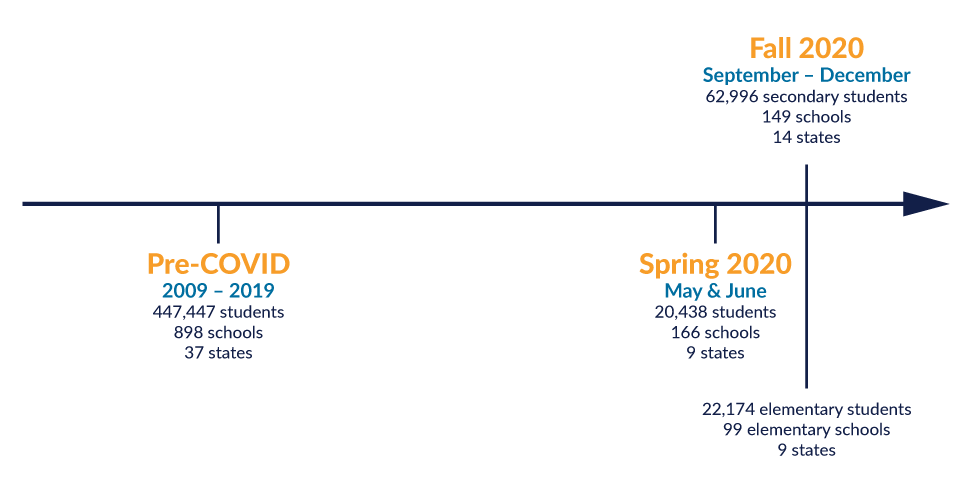
The fall 2020 secondary student sample draws from 14 states and represents a mix of students in urban (26 percent), suburban (45 percent), and rural (29 percent) settings.
Thirty-four percent of students in our sample are enrolled in high-poverty schools, compared to 25 percent of students nationally. A higher proportion of students in our sample identified as Hispanic or Latinx (32 percent versus 28 percent nationally) and multiracial (17 percent versus five percent nationally), while a lower proportion of students identified as white (38 percent versus 46 percent nationally), Black or African American (five percent versus 15 percent nationally), Asian (four percent versus six percent nationally), and American Indian or Alaska Native (.5 percent versus 1 percent nationally). Fewer than one percent of students identified as Native Hawaiian or Pacific Islander (.4 percent), similar to nationally. Students in the sample experienced a range of learning settings, with 21 percent attending school in person, 66 percent virtually, and 12 percent hybrid.
| California | New Hampshire | Rhode Island |
| Colorado | New York | Texas |
| Massachusetts | Ohio | Illinois |
| Maine | Oregon | Minnesota |
| Michigan | Pennsylvania |
Thirty-four percent of students in our sample are enrolled in high-poverty schools, compared to 25 percent of students nationally. A higher proportion of students in our sample identified as Hispanic or Latinx (32 percent versus 28 percent nationally) and multiracial (17 percent versus five percent nationally), while a lower proportion of students identified as white (38 percent versus 46 percent nationally), Black or African American (five percent versus 15 percent nationally), Asian (four percent versus six percent nationally), and American Indian or Alaska Native (.5 percent versus 1 percent nationally). Fewer than one percent of students identified as Native Hawaiian or Pacific Islander (.4 percent), similar to nationally. Students in the sample experienced a range of learning settings, with 21 percent attending school in person, 66 percent virtually, and 12 percent hybrid.
KEY FINDING 1
 Sixty-one percent of students said they learn a lot every day — up from 39 percent in the spring and on par with pre-pandemic levels — but experiences differ across student groups.
Sixty-one percent of students said they learn a lot every day — up from 39 percent in the spring and on par with pre-pandemic levels — but experiences differ across student groups.
In most of my classes, we learn a lot almost every day.
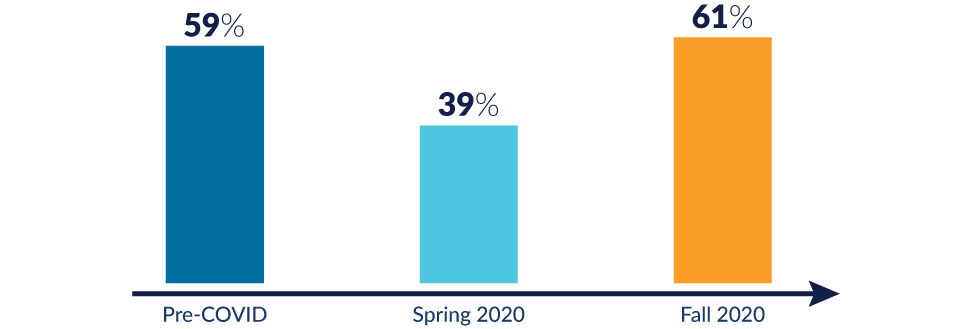
Additionally, students who get mostly As continue to respond more positively than other students. Sixty-six percent of students who get mostly As said they learn a lot almost every day, while 57 percent of students who get Bs, 48 percent of students who get mostly Cs, and 39 percent of students who get mostly Ds said the same. These differences in students’ experiences of consistent learning may relate to this fall’s grading crisis, exacerbating challenges for students already struggling academically.
In most of my classes, we learn a lot almost every day.
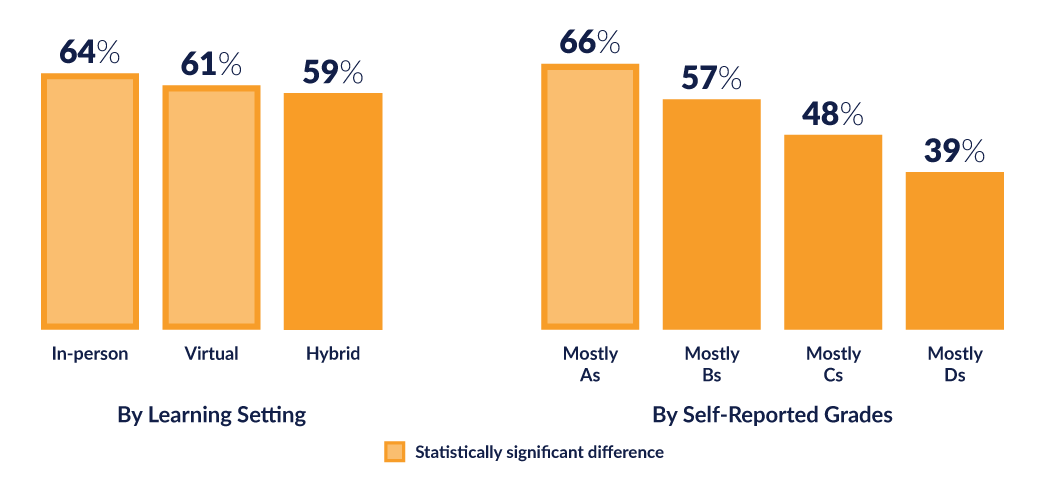
I am able to access my schoolwork.
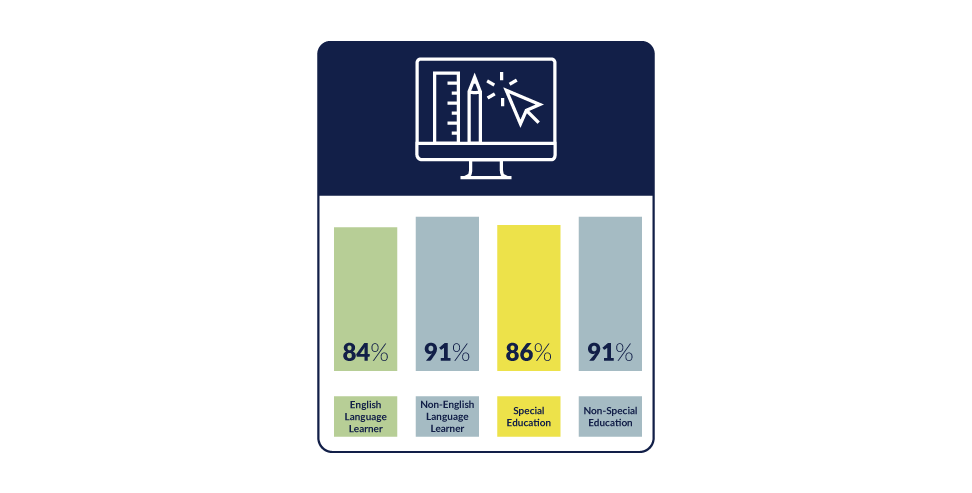
While distance learning…

SOCIAL INTERACTION
WHILE DISTANCE LEARNING
The amount of time spend…
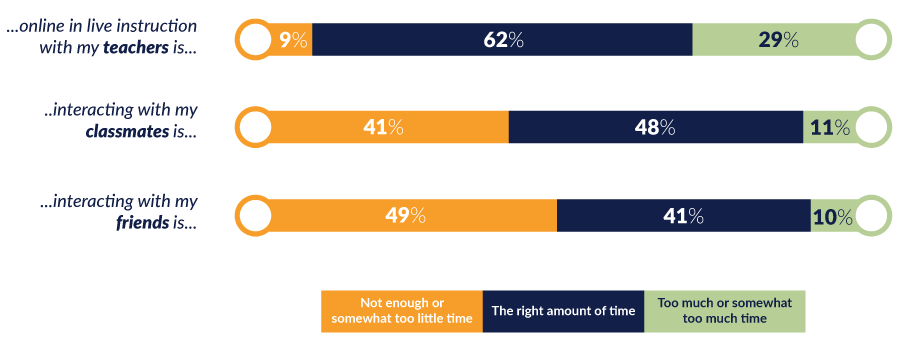
KEY FINDING 2
 Feeling depressed, stressed, or anxious has risen to the number one obstacle to learning. Hispanic or Latinx, multiracial, and Black or African American students faced more obstacles on average than did white or Asian students.
Feeling depressed, stressed, or anxious has risen to the number one obstacle to learning. Hispanic or Latinx, multiracial, and Black or African American students faced more obstacles on average than did white or Asian students.
Many months into the pandemic, feeling depressed, stressed or anxious — which was the second most frequently cited obstacle in spring 2020, at 39 percent — rose to the single most frequently cited obstacle in the fall.*
OBSTACLES TO VIRTUAL LEARNING
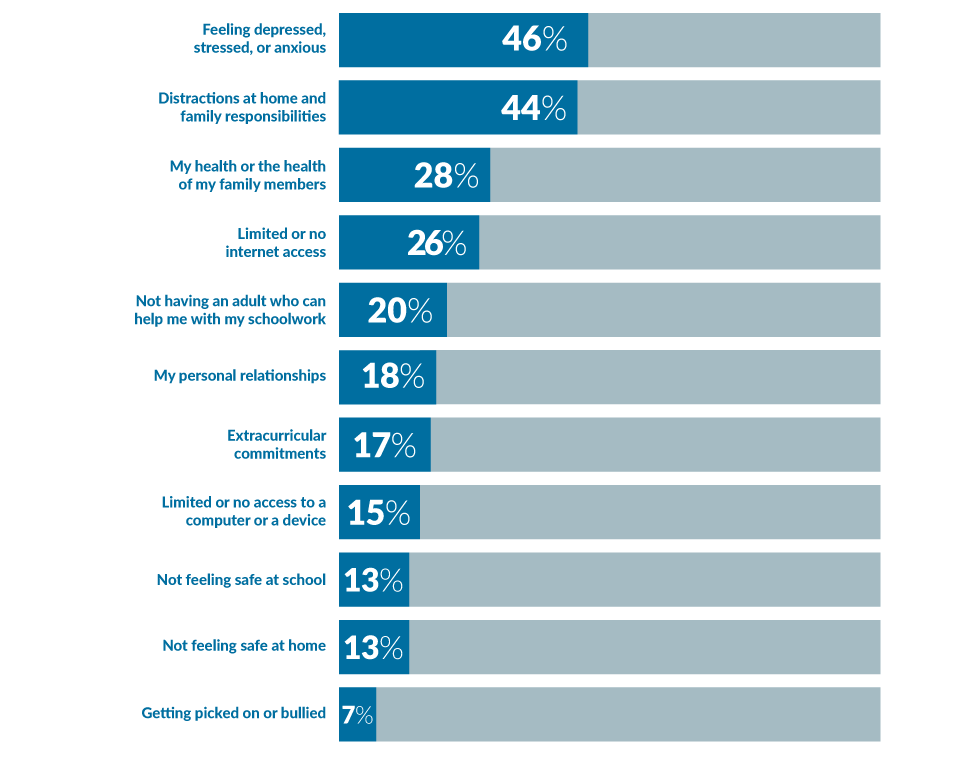
*The calculations described here are the proportion of students citing a given obstacle out of all students. In our spring 2020 report, the calculations were out of students citing at least one obstacle.
OBSTACLES TO VIRTUAL LEARNING
Do any of the following make it hard for you to do your best in school?
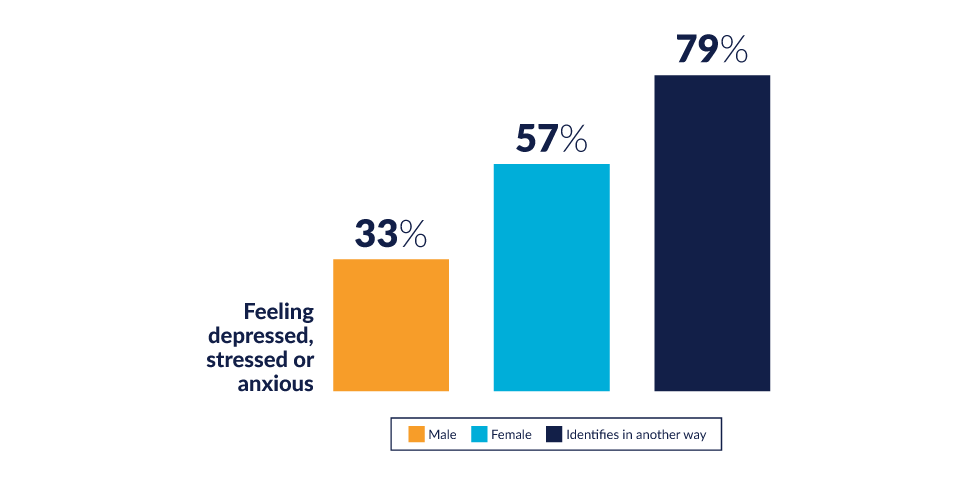
OBSTACLE LOAD
BY RACE/ETHNICITY
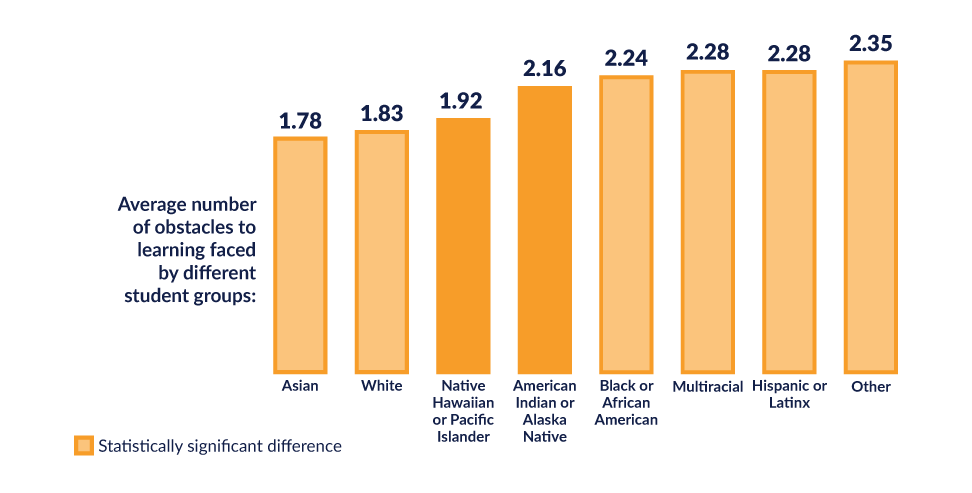
*These obstacle load scores are not directly comparable to the obstacle load scores we calculated in spring 2020 due to different numbers of obstacles students could cite.
Equity and the Digital Divide
Compared to their peers, a higher proportion of Hispanic or Latinx students and low-income students (students receiving free or reduced-price lunch) cited limited or no internet access, or limited or no access to a computer or device as obstacles to their learning. Thirty percent of Hispanic or Latinx students said limited or no internet access was an obstacle, compared to 23 percent of their peers. Similarly, 27 percent of low-income students cited this obstacle, relative to 20 percent of their peers. Regarding limited or no access to a computer or device, 19 percent of Hispanic or Latinx students cited this as an obstacle to learning, compared to 12 percent of their peers. Fifteen percent of low-income students cited access to a computer or device as an obstacle, versus only 8 percent of other students.
Obstacles to Learning
Do any of the following make it hard for you to do your best in school?

KEY FINDING 3
 Sense of belonging recovered from spring 2020, and students experienced increased academic support from their teachers.
Sense of belonging recovered from spring 2020, and students experienced increased academic support from their teachers.
I really feel like part of my school’s community.

During spring emergency distance learning, interpersonal support from teachers was a relative bright spot, with 43 percent of students reporting that many or all of their teachers make an effort to understand their lives outside of school — compared to only 26 percent before the pandemic. In fall 2020, the proportion of students responding positively fell back down to 30 percent.
Most of my teachers try to understand what my life is like outside of school.

Most of my teachers are willing to give
extra help on schoolwork if I need it.
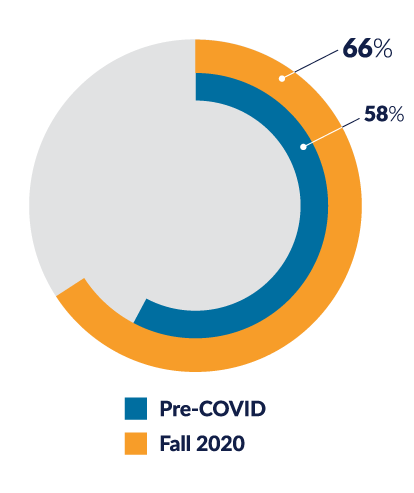
Most of my teachers don’t let people
give up when the work gets hard.
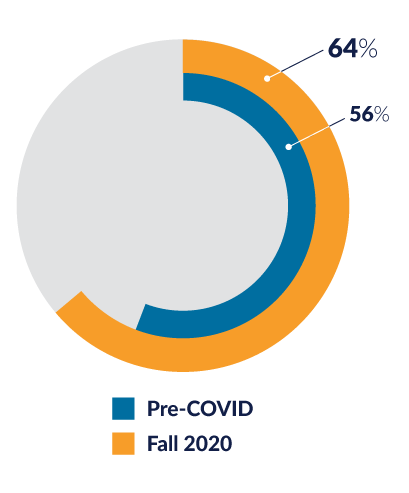
A NOTE ON PEER COLLABORATION
While students’ sense of belonging to their school recovered relative to the spring, the difficulty of organic peer connection during the pandemic was also reflected in student perceptions of collaboration. Students were asked a pair of questions about how often they work with other students, both when instructed by their teachers and without explicit direction. Forty-seven percent of students in fall 2020 said that they worked with other students for their classes somewhat or very often even when their teacher doesn’t ask or tell them to, on par with pre-pandemic levels. However, only 27 percent reported that they worked with other students somewhat or very often when their teacher didn’t ask or tell them to — a significant decline from 36 percent of students prior to the pandemic. In fact, working with other students even when their teacher didn’t ask or tell them to was the lowest rated item in the entire fall 2020 survey.
I work with other students for
my classes somewhat or very often…

KEY FINDING 4
 Males continued to rate their health and well-being more positively than did females and students who identify in another way. Overall, students reported less availability from adults in school to support their mental and emotional health, but more programs and services.
Males continued to rate their health and well-being more positively than did females and students who identify in another way. Overall, students reported less availability from adults in school to support their mental and emotional health, but more programs and services.
There was a notable difference in the frequency with which elementary and secondary students reported feeling energized: 71 percent of elementary school students said they often or very often feel energized, compared to only 45 percent of secondary school students.
In an earlier version of this question in spring 2020, secondary students rated the ability to connect with friends lower than all other items in the health and well-being scale (and in fact lower than all other questions in the entire survey). In fall 2020, the ability to connect with friends was the third highest rated item in the health and well-being scale, with 63 percent of secondary students saying they often or very often connect with friends.
This shift suggests that many students are adapting and finding ways to connect with friends, while others are still struggling to connect. There are significant differences by learning environment, with 75 percent of students learning fully in person responding positively about their ability to connect with friends, compared to 68 percent of those in a hybrid model and only 58 percent of students who are learning remotely.
This shift suggests that many students are adapting and finding ways to connect with friends, while others are still struggling to connect. There are significant differences by learning environment, with 75 percent of students learning fully in person responding positively about their ability to connect with friends, compared to 68 percent of those in a hybrid model and only 58 percent of students who are learning remotely.
HEALTH AND WELL-BEING
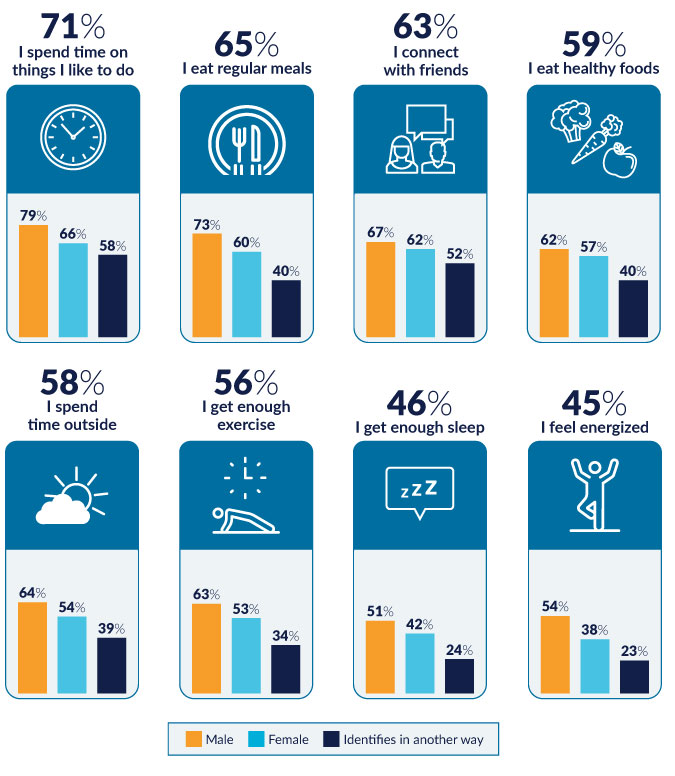
When feeling upset, stressed, or having problems, only 41 percent of students said there is an adult from their school who they can talk to about it — a decrease from 46 percent pre-pandemic.
EMOTIONAL & MENTAL HEALTH SUPPORTS
When I’m feeling upset,
stressed, or having problems…

Students were also asked if there is at least one adult in their school who would be willing to help with a personal problem. Only 49 percent of students said yes, compared to 64 percent pre-COVID.
There is an adult from school who would be
willing to help me with a personal problem.
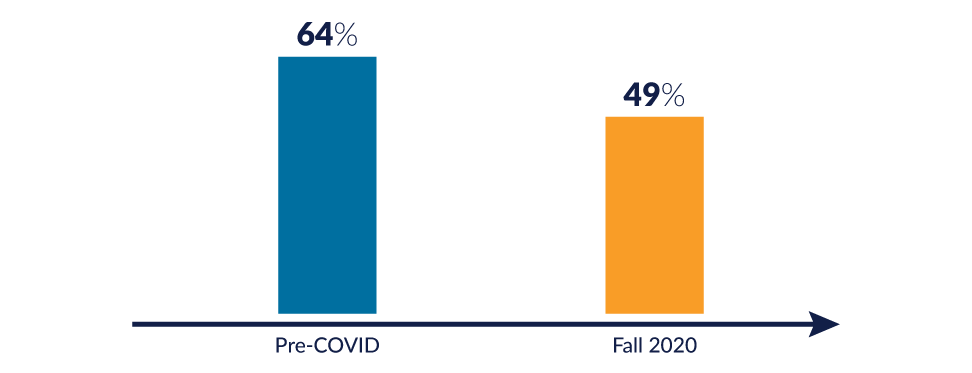
There is an adult from school who would be
willing to help me with a personal problem.

KEY FINDING 5
 One in four high school seniors’ postsecondary plans have changed since the start of the pandemic.
One in four high school seniors’ postsecondary plans have changed since the start of the pandemic.
SENIORS’ POSTSECONDARY PLANS
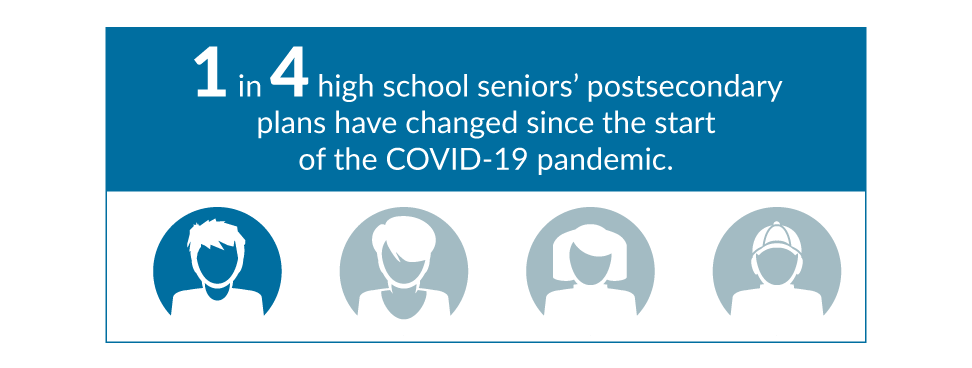
Changes in seniors’ plans also varied by race/ethnicity and by socioeconomic status, as echoed in other studies. Eighteen percent of white students said their plans have changed, relative to 30 percent of other students. Additionally, 28 percent of seniors receiving free and reduced-price lunch reported changing their plans, compared to 19 percent of other students.
The proportion of students expecting to attend four-year colleges and universities remained consistent in fall 2020 when compared to fall 2019 and before, averaging just over 50 percent in both time periods. The proportion of students planning to enroll in two-year college, however, decreased significantly, dropping from 22 percent before the pandemic to 16 percent in fall 2020. This finding echoes alarming reports of plummeting enrollments at two-year and community colleges across the country.
SENIORS’ POSTSECONDARY PLANS
After you finish high school, what do you expect to do next?
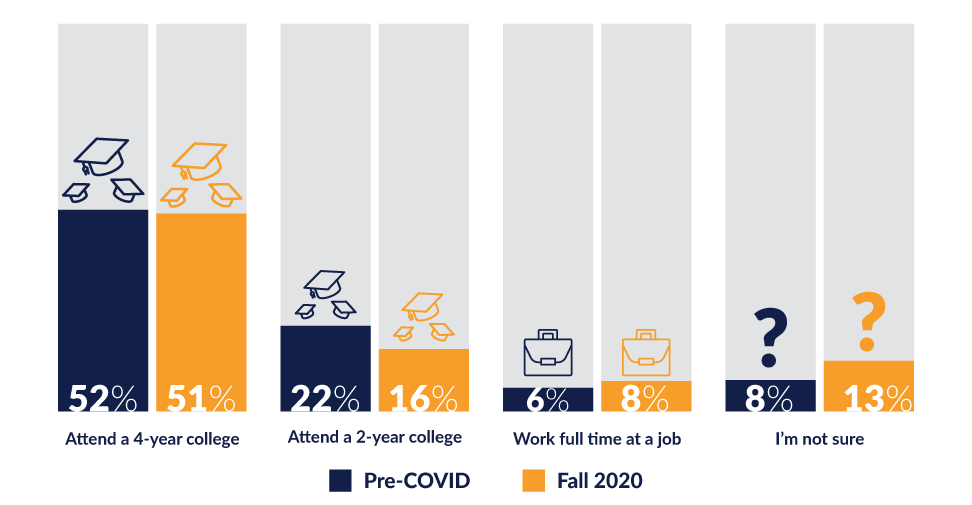
 In Students’ Own Words
In Students’ Own Words
What do you like most about your school?
What do you dislike most about your school?
What about learning at home do you like? Are there things you hope will stay the same next school year?
What about learning at home do you find challenging? How can your school help?
The first two questions were asked of all students. While students were not prompted to comment on remote learning, some of the most salient themes that emerged from our analysis related to the impact of learning from home. The distance learning questions were specific to the remote learning experience and were asked only of students in distance learning environments.
YouthTruth analyzed the full set of qualitative responses to identify broad themes within each question. The open-ended responses provide great insight into students’ shared experiences, while the nuances help contextualize the quantitative findings. The following themes emerged from the aggregated qualitative responses:
| Overall Likes | Overall Challenges |
| Teacher Support | Self Expression |
| Encouragement | Relevance |
| Culture of Care and Respect | Virtual Learning and Mental Health |
| Academic Challenge | Workload & Stress |
| Distance Learning Likes | Distance Learning Challenges |
| Free Time and Flexibility | Engagement and Motivation |
| Family Connection | Distractions |
| Comfortable Environments | Access to Internet or Devices |
| Sleeping In | Homework Load |
Qualitative Sentiment Analysis Methodology
For questions about students’ overall likes and challenges, we conducted an automated matching of self-reported themes to comments and used an English Language NLP library to clean and vectorize the qualitative data. Using an n-gram range of up to three words, we conducted a K Means clustering analysis to find emergent themes in the qualitative responses. We then categorized student comments into clusters based on common threads or sequences of words. To train and correct for noise in the comments, the self-reported themes were overlaid on the clusters to confirm the clusters’ accuracy in describing the theme of the comment. Finally, each theme was summarized using YouthTruth’s text summary tool, which compiles the responses within a cluster and identifies representative comments based on the number and type of keywords used in the comment.
For questions about students’ likes and challenges specific to the distance learning experience, the process differed slightly as there were no self-reported themes for these comments. We used an English Language NLP library to clean and vectorize a portion of the qualitative data into a test dataset. We employed a clustering algorithm on this sample of our data in order to find the optimal number of emergent themes and reduce noise during the exploratory phase of the analysis. Using an n-gram range of up to three words, we conducted a K Means clustering analysis on the entire dataset to find emergent themes in the qualitative responses. We then categorized student comments into clusters based on common threads or sequences of words. To train and correct for noise in the comments, the test dataset’s themes were overlaid on the complete dataset to confirm the clusters’ accuracy in describing the theme of the comment. Finally, each theme was summarized using YouthTruth’s text summary tool, which compiles the responses within a cluster and identifies representative comments based on the number and type of keywords used in the comment.
![]()
Teacher Support
“My teachers care about me by making sure I get help on any work when I need it. They make sure I understand everything I do. They encourage me to ask questions when needed. I remember when I had covid and was forced to go virtual my teacher was concerned and asked me about it. I also remember how the other day I wasn’t feeling good at all. I was very stressed and I was crying. My teacher asked me about it and tried to help me. All of this shows that my teachers care about me.”
Students appreciated the support they received from their teachers for challenges they faced both academically and personally. Some students who wrote about teacher support highlighted the personalized support that teachers provided during office hours: “Whenever we need extra help they always help us during office hours.” Another student remarked, “office hours are great because it gives you one on one time with your teachers/instructors. In office hours you can get additional help with the criteria in class or just explain in ways to get your grades up.” Students also noted that teachers were willing to lend more personal support: “My choir teacher and my asl teacher are both absolutely amazing and I feel very comfortable around [them] and I feel like I would be able to tell them anything.” Over the course of a challenging fall, students acknowledged the different ways that their teachers are there for them. As one student explained, “They make you feel like you’re safe, you can trust them, and that you can always come to them if you need them, and that’s how it should be.”
Encouragement
“My school inspires me to do my best because I know my teachers care if I do well and want me to try my best. I too have standards for myself to do my best. The teacher’s caring makes me want to do it for them too, not just because I want good grades.”
Students noted the ways in which their teachers’ expectations and encouragement motivates them. “I think that one way they inspire me is by encouraging me to do my best.” Students described how their instructors teach them “to not get sloppy and to not just give up,” but rather to “be hardworking.” Students feel as though their teachers are looking out for them and making sure they are getting the most out of their education, like one student who wrote: “They teach us to never give up and do our best. I wanted to give up on math. But my teacher did not let me give up until i did it.” In addition to academic expectations, students appreciate that adults at school set high expectations for students’ growth and development as people. One student shared, “a lot of the staff constantly say just try your best or be your best you … because that’s what everyone wants to see.”
Culture of Care and Respect
“Each staff member acknowledges and takes into account students’ schedules and abilities when they are online. Staff members also make sure everyone has what is best specifically for them, while keeping each student equal and appreciated. Students treat teachers with respect because they understand that teachers have outside lives and families responsibilities which may be the reason why the teachers can’t answer emails or be available 24/7.”
Students appreciated their school’s culture of mutual respect. One student wrote: “it always feels like a family when I come to school.” Some students described how the respect that teachers have for them allows them to be more comfortable communicating and expressing themselves, like the student who said: “I feel respected pretty much the whole time while I am at school and feel like I can express myself easily without feeling like I am going to get judged.” Other student comments expressed how they feel heard by their teachers and that this relationship goes both ways: “From what I have seen everyone listens to one another. If a student is talking, the teacher will respect what they say and listen. Same for staff, the students listen and respect what the staff is saying.” Students also wrote about the care they show for each other, in one student’s words: “the students here are so friendly, if you are having a bad day there is always at least one student that is willing to try to help cheer up your day.”
Academic Challenge
“I believe that my classes help me think, ask questions, learn, and wonder about the world.”
A number of students expressed that they liked how their schoolwork challenges them. Students described how their teachers urge them to think critically. One student commented on the ways their teachers and classes encourage them to seek deeper understanding: “[In] my English class our teacher challenges us to dig into what the meaning of the story is … My science teacher has us write about the experiment in a way that makes us think about what we learned and how our data connects to our claim.” Another student commented, “They challenge us to dig into the meaning of the information we had learned and pull out key elements to put into our writing.”
Self Expression
“Times are changing and so should some dumb rules.”
Students shared critical sentiments about their ability to express themselves freely at school. Some students took issue with school policies. One student wrote about the dress code, “I genuinely do not like the school dress code. One main reason I’m inspired to do my best during school is by expressing myself in the choice of clothing I have.” Other students described differences of opinion between themselves and other classmates and staff. One student wrote, “Many students feel as though their ideologies clash heavily with either their school or their peers. Students dislike that they are not able to talk comfortably with one another.” Another student identified challenges with self expression and acceptance, explaining, “I feel constantly judged at school for who I am. Stereotypes are also horrible at our school. Depending on what activity you do, people will judge and make fun of you.” One student, recognizing the complexity of these issues, notes, “I know a lot of [these] things the district itself can’t control, and that’s ok. But the things you can control, please try to do something.”
Relevance
“I do not know what the real world is like, I do not know what to do in the career that I want to go into. I do not know anything but how to pass a test. I know how to find ways to cheat. I know how to forget. My school has failed to inspire me to work and it has failed to teach me how to survive under any circumstance that is not inside a classroom.”
Some students expressed concern that their coursework does not feel relevant to their future careers and life outside of school. One student described that “most of the work we were given was busy work that [we] would never use.” Others expressed frustration with “focusing on the state tests,” and a desire to learn “things that can literally help [them] in the real world.” In addition to less busywork, some students wished for more coursework that is directly applicable to life skills like “cooking, how to pay rent and manage my money, how to make smart money choices, how to find a job and make a reasonable resume, how to communicate.” Other students described a desire for greater support navigating postsecondary options and uncertainties. One student wrote, “we need more guidance about choosing colleges. By giving us help with choosing which colleges are best for our interests, as well as helping us to explore potential career options.”
Virtual Learning and Mental Health
“So many people’s grades and mental health have been struggling. My anxiety has never been as bad as it is when in zoom calls and we are moving so fast and then some teachers are not understanding.”
A number of students honed in on challenges surrounding virtual learning and the impact on their mental health. Students shared how Zoom and online interactions with teachers and classmates have increased their stress and anxiety levels. One student explained, “my anxiety has never been as bad as it is when I’m in zoom calls and we are moving so fast …. Some teachers don’t realize how 25% of students or more are just not doing well and 99% dislike online school.” Another student described their difficulty keeping up while learning fully remotely because they “learn on paper, with visuals” and have a hard time following coursework on the screen. Other students feel as though they are spread thin at home, caught between school and home responsibilities. One student wrote, “I’m stressed out everyday because not only do I have to do a ton of homework, but I also have responsibilities at home and I’m also facing a very serious situation. This all just stresses me out and sometimes I feel like giving up on trying to complete everything.”
Workload and Stress
“I have little time to spend time with my family, eat, do my chore, write in a journal, have fun time on screens, talk on the phone, skate around on my skateboard, play with my little brother. I love some of my family so much and my time with them feels so limited, just like the time we have to live. Sometimes my life feels boring or bland and homework is causing stress and not helping at all.”
Students noted their workload in the fall to be challenging. “I really dislike the amount of homework I receive each week. I feel it doesn’t improve my understanding, it’s too hard, it’s time consuming, and it leaves no time or opportunities to do the things I love.” Some students explained that they would prefer to have more learning time in class and less homework. “I don’t like the amount of homework. It doesn’t make sense to have a short learning session and long homework. I don’t really think we need that much homework, there’s other ways to test to see if they are truly understanding, and I feel like we should do more activities that get us into learning the subject.” For some students, the increased workload is causing stress. One student shared: “They just give us more work, and more work, and more work…a project, and then more work x6 classes. It’s stressful. It’s getting to the point where I and many others feel like it’s a useless waste of time. I don’t feel like doing my work anymore. There’s so much of it.”
Free Time and Flexibility
“I like the leniency with time that they give us. They let us do our work at our own pace and know that this year is more stressful because we’re not in school. I hope that next school year they still understand that even though we’re not in virtual classes it is still stressful.”
When learning from home, students enjoyed the free time and flexibility that a virtual learning environment offered them. One student notes, “I feel less stressed and rushed. I feel like I have more free time to do the things I enjoy. Next school year, I hope that my classes continue to stay…not as rushed… also hope that I will continue to have some free time.” Other students described appreciation for having more agency over their schedules during the week, allowing them to spend more time with family and have unstructured time to get their schoolwork done. One student wrote, “The best thing about learning at home is that I have free time to hang out with friends and do things I love. When I was at in-person school, the only free time I had was the weekends.” Students’ open-ended comments described their hope that schools will structure classes similarly in the future so as to give students more free time.
Family Connection
“I am able to spend more time with my family and enjoy time with them.”
A positive theme that carried over from spring 2020 distance learning was family connection. Students enjoyed the ability to spend more time with their family while learning remotely. “Since I’m home I finish around 2:30 or 3 and my family and pets are right here at my house and I could spend time with them,” one student remarked. Many students stress how drastically distance learning has changed their home lives. In one reflection, a student recalls, “when we had in person class I would be gone for 7 hours, come back home, eat and then go to my room to finish all of my homework. I wasn’t always able to spend time with my family.” Students shared in their comments the hope that they can return to school next year but still spend more time with family.
Comfortable Environments
“I like that we can work in the comfort of our own homes, we don’t have to get up as early, we can take naps after class, we can eat during some classes.”
A high point for some students that experienced virtual learning this year was learning in a comfortable environment. Students appreciated being able to create a learning environment that worked for them by attending online classes and completing their schoolwork in a comfortable place in their own home, taking breaks, eating, or resting when they needed to. One student wrote, “I like being in my bed and learning. I hope we have some in class and some virtual classes.” Another student expressed appreciation for being home and not having to commute to school “on really cold days. I can just stay in my house warm and I can eat at any time I want to.”
Sleeping In
“What I like about learning at home is that I don’t have to wake up as early.”
Many students felt that a positive aspect of virtual learning was that they were able to sleep in. Students did not tend to describe getting more sleep, but rather spoke specifically about sleep schedule and the ability to wake up later than when they are attending school in person. One student commented, “Some things I like about at-home learning is not having to wake up early and get ready.” While many students appreciated being able to stay home and sleep in, these sentiments did not outweigh their desires to return to in-person learning. As one student explained, “Some things I like about online learning are that I don’t have to wake up so early, but I would prefer to wake up early if we could go to school.”
Engagement and Motivation
“I think the biggest hardship with learning from home is that I find myself with absolutely no desire to work. It’s habitual to get into my classes every day, but I find it hard to pay attention, hard to focus, hard to care.”
Many students wrote about the challenge of engaging with online learning. Some students described anxiety related to participating in online school that made it difficult for them to engage, while others described difficulty paying attention coupled with a lack of motivation to complete schoolwork. Some students found it challenging to ask questions over Zoom. “Even though teachers ask if we have questions or are having trouble I don’t speak up as much as I would in class.” One student explained that when they are learning online, “it’s so easy to not pay attention.” Students also noted the difficulty of staying motivated amidst the prolonged pandemic and distance learning experience. One student explained, “we can’t do anything, sports have fewer practices, clubs are cancelled . . . it’s difficult to keep up motivation. Students are failing classes because they’ve got nothing to inspire them and make them actually try.”
Distractions
“It’s [easy to be] distracted by things around the house. Even if I’m in a quiet room, I’m still easily distracted. At least back at school nothing but the other students can really distract you . . . but now everyone, even the teachers can be easily distracted.”
A challenge that carried over from spring 2020 emergency distance learning was distractions at home. Students described distractions brought on by their family members and pets, lack of a quiet work place, as well as TV and other activities that make it difficult to focus at home. One student remarked, “I have my pet in the room and little things to fiddle with in my room and can hear my parents and siblings in the other rooms.” One student reflected on the differences between their distance learning experience with that of being in a classroom: “Classrooms for the most part are quiet, giving you a space to focus. Unless you’re an only child that will not even come close to the case for being at home.” Another described how the plethora of distractions has been impacting their work: “Being at home can get you lazy and want to go to sleep whether you are laying down on a couch or in your bed because of this I sometimes have trouble turning in work.”
Access to Internet or Devices
“Wifi problems occur and it makes [school] harder.”
The mechanics of online learning, including access to the internet and devices, proved challenging for a number of students. Students frequently mentioned issues with wifi connectivity, stating that “sometimes I have wifi problems or zoom problems,” and “I have wifi problems so I sometimes get kicked out or it lags and I’m later than others.” Some students offered suggestions that their school supply them with hotspots. Students also noted concerns with technology requirements. One student shared, “What I find challenging is the requirements needed for the Zoom, such as the webcam and microphone.” Other students described technology related challenges that made the online classroom environment difficult to engage with. As one student explained, “[the] teacher’s voice cutting out or not being let into class [is challenging]. When on a hybrid schedule teachers don’t pay attention to online kids.” Students’ open-ended responses described their hope that teachers will be more understanding about wifi issues.
Homework Load
“It feels like I can never spend time with family and friends because they give us so much homework.”
While learning remotely, students expressed concern with the amount of homework they receive from their teachers. “Learning at home is challenging because of homework. I don’t mind homework but when you go overboard with it and think you’re the only class assigning it, well you’re wrong,” noted one student. Some students were frustrated that there was not more feedback or support for their homework As one student wrote, “I never know whether my work is correct or not for my homework. It only hurts especially when almost all of my homework is not graded.” Another student suggested more structured support: “Maybe have homework more accessible or a seperate program like Google teams or something for homework specifically.” Students overwhelmingly felt that their school and teachers could be more accommodating around homework: “Homework definitely should be reduced considering that we need breaks that are longer than 15-30 minutes.” Some students craved greater empathy from their teachers regarding balancing their homework with their responsibilities and lives outside of school. In the words of one student, “what [teachers] do not know is that we also have chores to do at home or siblings to help and take care of. . . . It just feels overwhelming because the homework piles up. . . . They think we do not have a life outside of school; it just makes me frustrated.”
Conclusion
As the U.S. continues to navigate the pandemic’s course, the vaccine rollout, and what these mean for schools’ ongoing operations and ultimate reopening, there is a critical opportunity to listen directly to students. Their lived experiences offer unique insights into what it means to be a student right now. As we navigate the challenges of this moment and the days ahead, students’ voices must be central to the way school is reimagined to best serve students during this difficult time.
Acknowledgements
We are very appreciative of the support from the Bill & Melinda Gates Foundation, which provided funding for this report. The findings and conclusions contained within are those of the authors and do not necessarily reflect positions or policies of the foundations.
We would also like to thank the following foundations for their support of the first report in this series: William and Flora Hewlett Foundation, the Walton Family Foundation, and the Carnegie Corporation of New York.
Finally, this work would not be possible without the partnership of the hundreds of schools who elevate student voices within their local communities and the over half-million students who have shared their insights and expertise by weighing in. A heartfelt thank you to each anonymous voice represented here. We hear you.
Take Action
Want to learn more about you can gather student feedback to drive improvements in your school or district?
